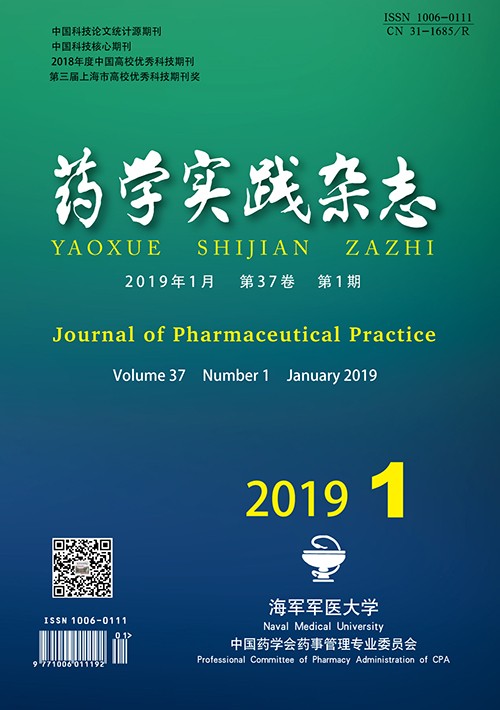HONG Chen, HU Wenjun, WANG Shuna, LI Zhiyong, MIAO Chaoyu. Establishment and evaluation of in vivo and in vitro D-galactose induced cognitive impairment models[J]. Journal of Pharmaceutical Practice and Service, 2019, 37(1): 14-18,73. doi: 10.3969/j.issn.1006-0111.2019.01.004
| Citation:
|
HONG Chen, HU Wenjun, WANG Shuna, LI Zhiyong, MIAO Chaoyu. Establishment and evaluation of in vivo and in vitro D-galactose induced cognitive impairment models[J]. Journal of Pharmaceutical Practice and Service, 2019, 37(1): 14-18,73. doi: 10.3969/j.issn.1006-0111.2019.01.004
|
Establishment and evaluation of in vivo and in vitro D-galactose induced cognitive impairment models
-
Department of Pharmacology, School of Pharmacy, Naval Medical University, Shanghai 200433, China
- Received Date: 2018-07-02
- Rev Recd Date:
2018-09-12
-
Abstract
Objective To construct and explore the in vivo and in vitro D-galactose induced cognitive impairment models and evaluate the application value of the combined models in the study of cognitive impairments. Methods The cognitive impairment mice model induced by D-gal was prepared by continuous intraperitoneal injection of D-gal saline solution for 8 weeks, followed by detection of learning and memory functions with Morris water maze. The related molecular markers in the brain tissue were assayed to evaluate the effect and application value. D-gal cell model was prepared by adding D-gal in different concentrations into the cell cultural medium of neurons harvested from the hippocampus of young mice. The effect and application value were evaluated by detecting the molecular markers related to the level of cell injury. Results The Morris water maze on the D-gal model showed that the learning and memory functions of mice in the model group were significantly lower than those in the control group. Meanwhile, the levels of apoptosis and oxidative stress in the model group were significantly higher than those in the control group. In the hippocampal neuron model of D-gal, the neurons showed a dose-dependent morphologic and functional change with the increase of D-gal dose and the levels of apoptosis and oxidative stress were significantly higher than those in the negative control. Conclusion D-galactose can be successfully used to induce cognitive impairment models both in vivo and in vitro through the decrease of the learning and memory functions of mice and induction of apoptosis and oxidative stress in neurons. Combined application of the two models of D-gal can be one of effective and promising tools for the study of cognitive impairment and pharmacodynamic evaluation.
-
References
|
[1]
|
MIQUEL S, CHAMP C, DAY J, et al. Poor cognitive ageing:vulnerabilities, mechanisms and the impact of nutritional interventions[J]. Ageing Res Rev, 2018, 42:40-55. |
|
[2]
|
CHAN K Y, WANG W, WU J J, et al. Epidemiology of Alzheimer's disease and other forms of dementia in China, 1990-2010:a systematic review and analysis[J]. Lancet, 2013, 381(9882):2016-2023. |
|
[3]
|
KANG E, WEN Z, SONG H, et al. Adult neurogenesis and psychiatric disorders[J]. Cold Spring Harb Perspect Biol, 2016, 8(9):a019026. |
|
[4]
|
ERNST A, ALKASS K, BERNARD S, et al. Neurogenesis in the striatum of the adult human brain[J]. Cell, 2014, 156(5):1072-1083. |
|
[5]
|
ALI T, BADSHAH H, KIM T H, et al. Melatonin attenuates D-galactose-induced memory impairment, neuroinflammation and neurodegeneration via RAGE/NF-K B/JNK signaling pathway in aging mouse model[J]. J Pineal Res, 2015, 58(1):71-85. |
|
[6]
|
VORHEES C V, WILLIAMS M T. Morris water maze:procedures for assessing spatial and related forms of learning and memory[J]. Nat Protoc, 2006, 1(2):848-858. |
|
[7]
|
MIYAMOTO T, STEIN L, THOMAS R, et al. Phosphorylation of tau at Y18, but not tau-fyn binding, is required for tau to modulate NMDA receptor-dependent excitotoxicity in primary neuronal culture[J]. Molecul Neurodegen, 2017, 12(1):41. |
|
[8]
|
HUSAIN M, MEHTA M A. Cognitive enhancement by drugs in health and disease[J]. Trends Cogn Sci (Regul Ed), 2011, 15(1):28-36. |
|
[9]
|
SHWE T, PRATCHAYASAKUL W, CHATTIPAKORN N, et al. Role of D-galactose-induced brain aging and its potential used for therapeutic interventions[J]. Exp Gerontol, 2017, 101:13-36. |
|
[10]
|
WEI H, LI L, SONG Q, et al. Behavioural study of the D-galactose induced aging model in C57BL/6J mice.[J]. Behav Brain Res, 2005, 157(2):245-251. |
|
[11]
|
SADIGHETEGHAD S, MAJDI A, MCCANN S K, et al. D-galactose-induced brain ageing model:a systematic review and Meta-analysis on cognitive outcomes and oxidative stress indices[J]. Plos One, 2017, 12(8):e0184122. |
-
-
Proportional views

-







 DownLoad:
DownLoad: